Ever sat with your finger hovering over the "Book Now" button, wondering if you're choosing the right month to visit Bhutan? You're not alone. Timing your trip to this Himalayan kingdom can make the difference between magical mountain views and days lost to monsoon downpours.
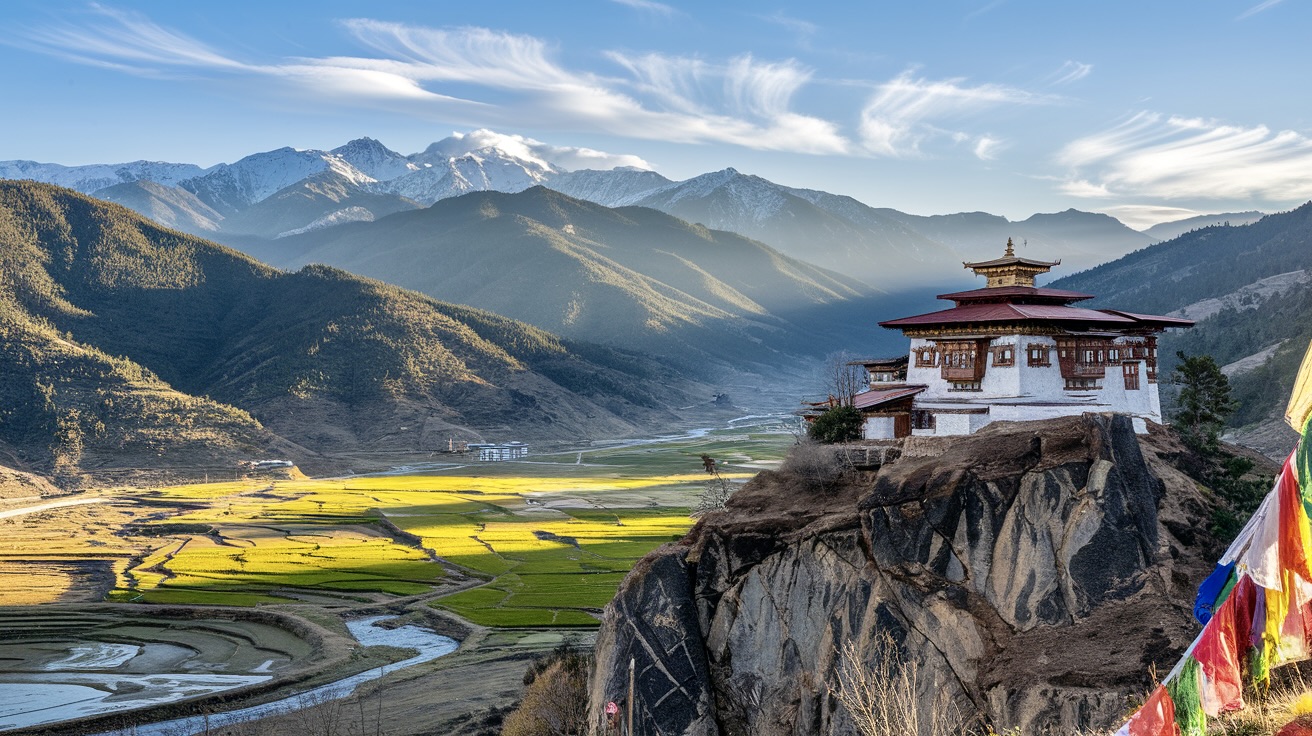
I'll walk you through exactly when to visit Bhutan for your specific travel style, whether you're chasing festivals, blue skies, or budget-friendly options.
The best time to visit Bhutan typically falls between October and December, when clear skies showcase the majestic mountains and temperatures remain comfortable for exploring ancient dzongs and high-altitude treks.
But here's what the glossy travel brochures won't tell you about those "shoulder seasons" that might actually be perfect for your particular adventure...
Understanding Bhutan's Seasonal Climate
Bhutan's weather is characterized by clear skies, intense sunlight, and significant temperature fluctuations between day and night. With its distinct seasons, the country offers a unique rhythm to explorers, with temperatures typically ranging from 5°C to 20°C across different regions.
Spring (March-May): Ideal for wildflowers and clear views
Spring in Bhutan truly brings the country to life. During these months, valleys transform into vibrant tapestries as rhododendrons, magnolias, and wildflowers burst into bloom. Temperatures range from 8°C to 24°C (46.4°F to 75.2°F), creating perfect conditions for outdoor activities and photography.
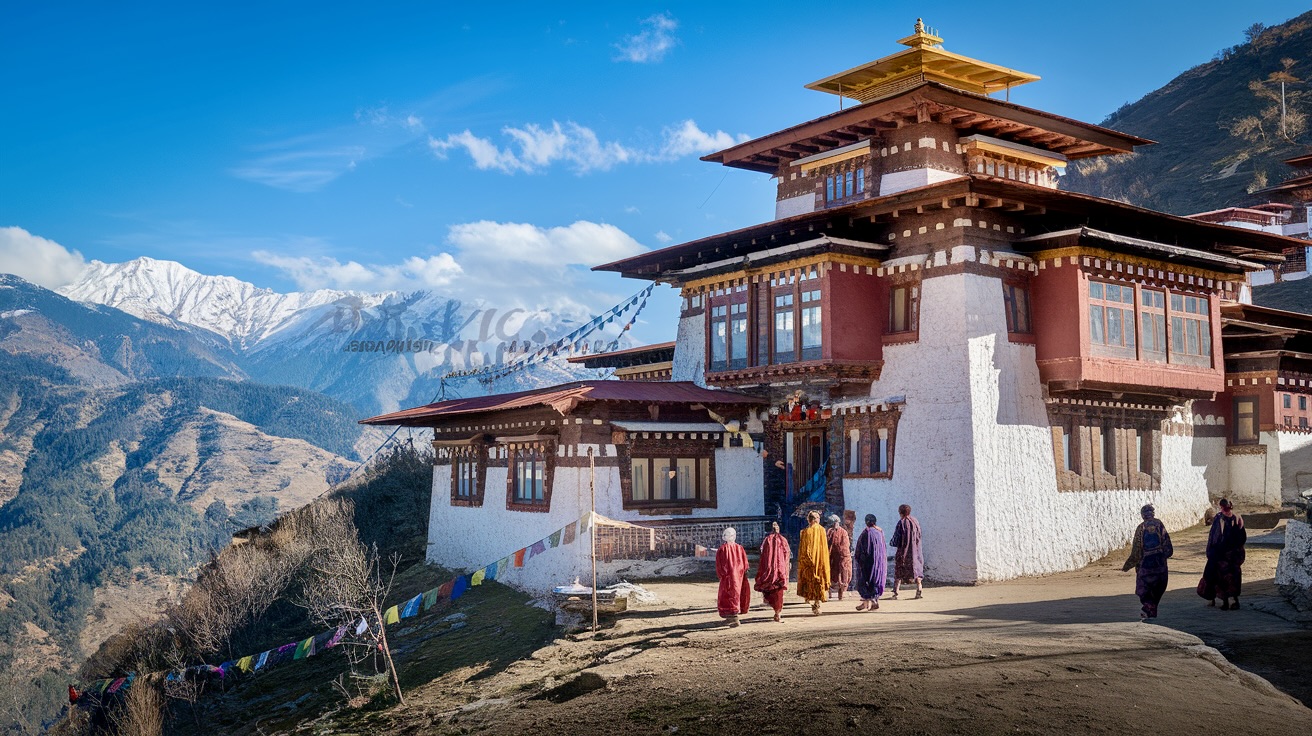
The crisp air, resilient greenery, and vast blue skies offer spectacular views of snow-capped mountains. This season is also rich with cultural experiences, featuring some of Bhutan's most colorful festivals like the Paro Tshechu and Punakha Tshechu.
For your spring visit, we recommend packing light clothing like shirts and jeans, along with a hoodie or thin coat for cooler evenings. Spring is undoubtedly one of the best times to visit Bhutan, especially for nature enthusiasts and photographers seeking to capture the country's natural beauty.
Summer/Monsoon (June-August): Wet season with limited visibility
Summer in Bhutan coincides with the monsoon season, bringing increased rainfall and humidity. Temperatures hover between 17°C and 26°C (62.6°F to 78.8°F), with southern regions experiencing temperatures up to 34°C (93.2°F) in places like Samdrup Jongkhar.
While the increased precipitation transforms landscapes into lush green paradises with terraced rice fields and vibrant forests, it also creates challenges for travelers. Mountain views are often obscured by clouds, and road travel can be hampered by occasional landslides.
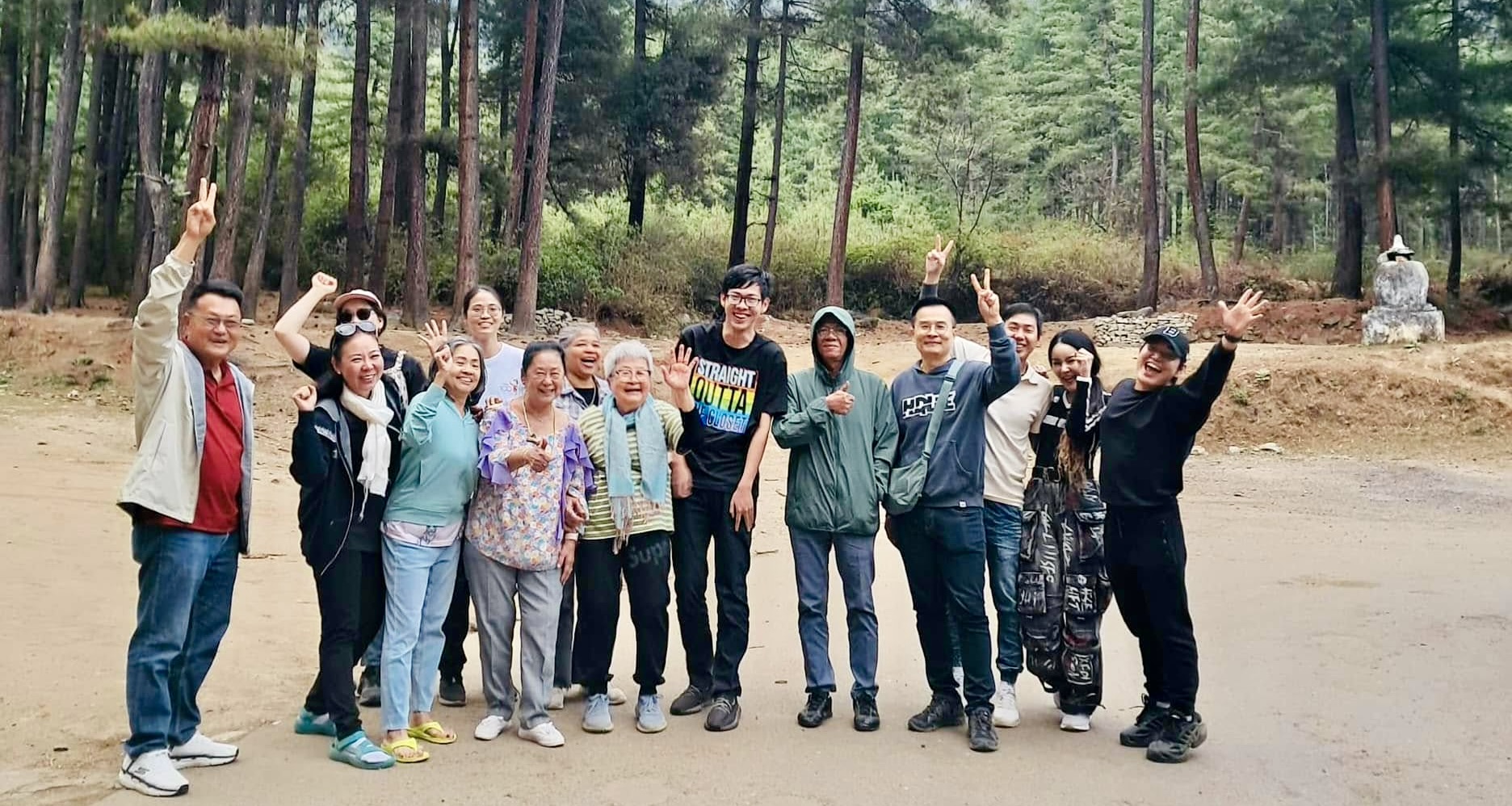
Unlike other parts of the Himalayas, Bhutan's monsoon showers are typically light and often occur in the late afternoon or early evening, leaving daytime hours available for exploration. This makes it possible to visit cultural sites and cities like Thimphu and Punakha, though we recommend carrying a raincoat for unexpected showers.
For summer visits, lightweight clothing like T-shirts, light pants, and dresses is appropriate, along with non-slip hiking shoes for potentially slippery trails.
Fall/Autumn (September-November): Perfect for clear skies and festivals
Autumn is widely considered the prime season for visiting Bhutan. As the monsoon retreats, the skies clear to reveal breathtaking views of the Himalayas. Temperatures range from 7°C to 25°C (44.6°F to 77°F), creating ideal conditions for outdoor activities and exploration.
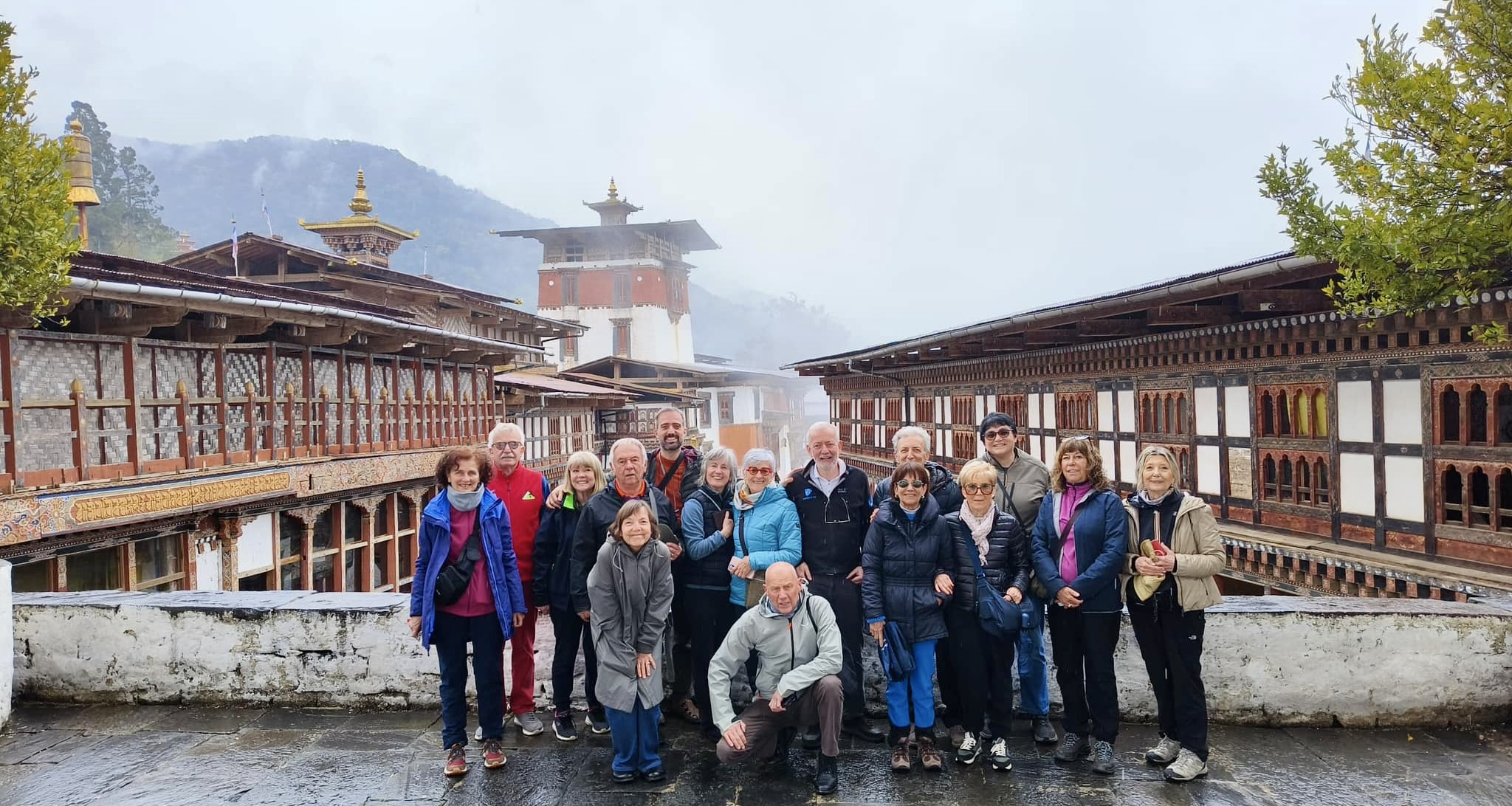
This season marks harvest time, with valleys and hills transitioning from lush green to golden yellow. The air is fresh, and visibility is exceptional, making it perfect for trekking and photography. September signals the start of the hiking season, with spectacular views and a pleasant climate.
Autumn also hosts many of Bhutan's major cultural festivals, including the grand Thimphu Tshechu—one of the country's biggest celebrations. The Jambay Lhakhang Drup Festival in October and the Black Necked Crane Festival in November offer authentic cultural experiences with fewer tourists than the spring festivals.
For autumn visits, we recommend packing shirts, jeans, a hoodie, and a jacket to adapt to the varying temperatures throughout the day.
Winter (December-February): Cold but clear with fewer tourists
Winter in Bhutan brings cold temperatures but rewards visitors with crystal-clear skies and stunning views of snow-covered mountains. Temperatures range from 2°C to 14°C (35.6°F to 57.2°F) in most valleys, with higher elevations experiencing below-freezing conditions, especially at night.
While the mountain passes receive significant snowfall, lower altitudes remain accessible. The days are typically sunny and bright, though mornings and evenings can be chilly. This season offers a more serene experience with fewer tourists, allowing for a deeper immersion in the country's culture and traditions.

Winter is the perfect time to visit Phobjikha Valley to witness the elegant black-necked cranes that migrate from the Tibetan plateau. These endangered birds arrive in November and stay until late February, making it a special attraction for wildlife enthusiasts.
For winter visits, we recommend packing warm layers, including shirts, jeans, a thick jacket, and a coat. The cold is manageable, and the clear skies offer excellent opportunities for photography and peaceful exploration of cultural sites.
Regional Weather Variations in Bhutan
Southern Regions: Subtropical climate with hot summers
In the southern belt of Bhutan, which sits at the foothills of the Himalayas (150-2,000 meters above sea level), we find a distinctly subtropical climate characterized by high humidity and heavy rainfall. This region experiences average temperatures ranging from approximately 15°C to 30°C year-round, making it significantly warmer than other parts of the country.
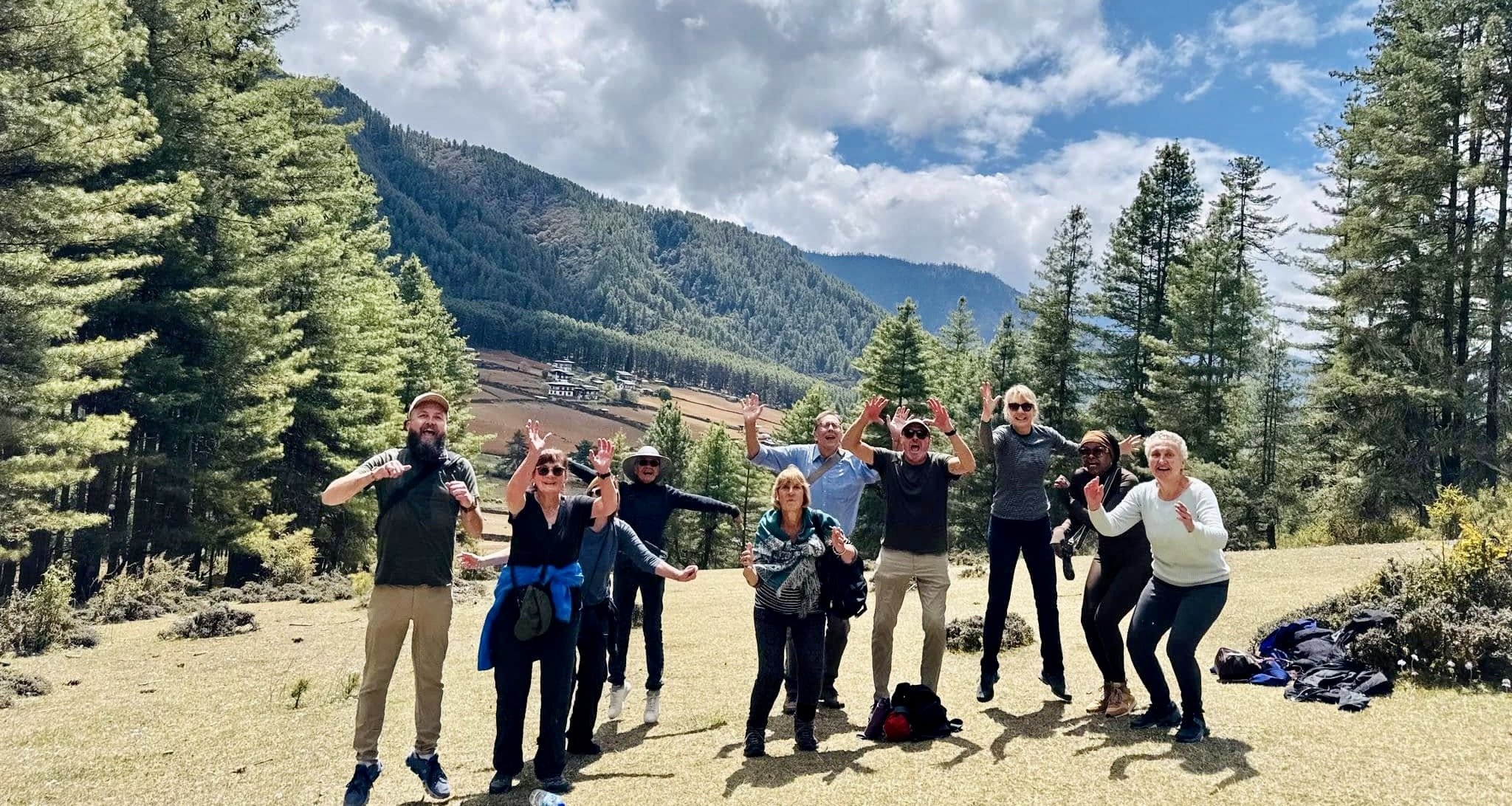
The southern plains, particularly areas like Phuntsholing, experience hot summers with daytime temperatures often reaching 32-33°C. During July and August, temperatures can occasionally spike to as high as 38-40°C. This subtropical zone receives the country's highest annual precipitation, with some areas recording an astonishing 5,000-6,000 mm of rainfall. The Duars Plain region is especially notable for its humid and hot conditions.
The southern region serves as Bhutan's main food-producing area due to its fertile soil and favorable growing conditions. The abundant rainfall supports lush vegetation and dense forests, creating a stark contrast to the alpine conditions found in the northern parts of the country.
Central Valleys: Moderate climate with warm summers and cool winters
The central region of Bhutan consists primarily of river valleys situated between 2,000-4,000 meters above sea level. Here we experience a temperate climate that's characterized by cool winters, warm summers, and moderate rainfall. This is where most of Bhutan's population is concentrated, including the capital city of Thimphu.
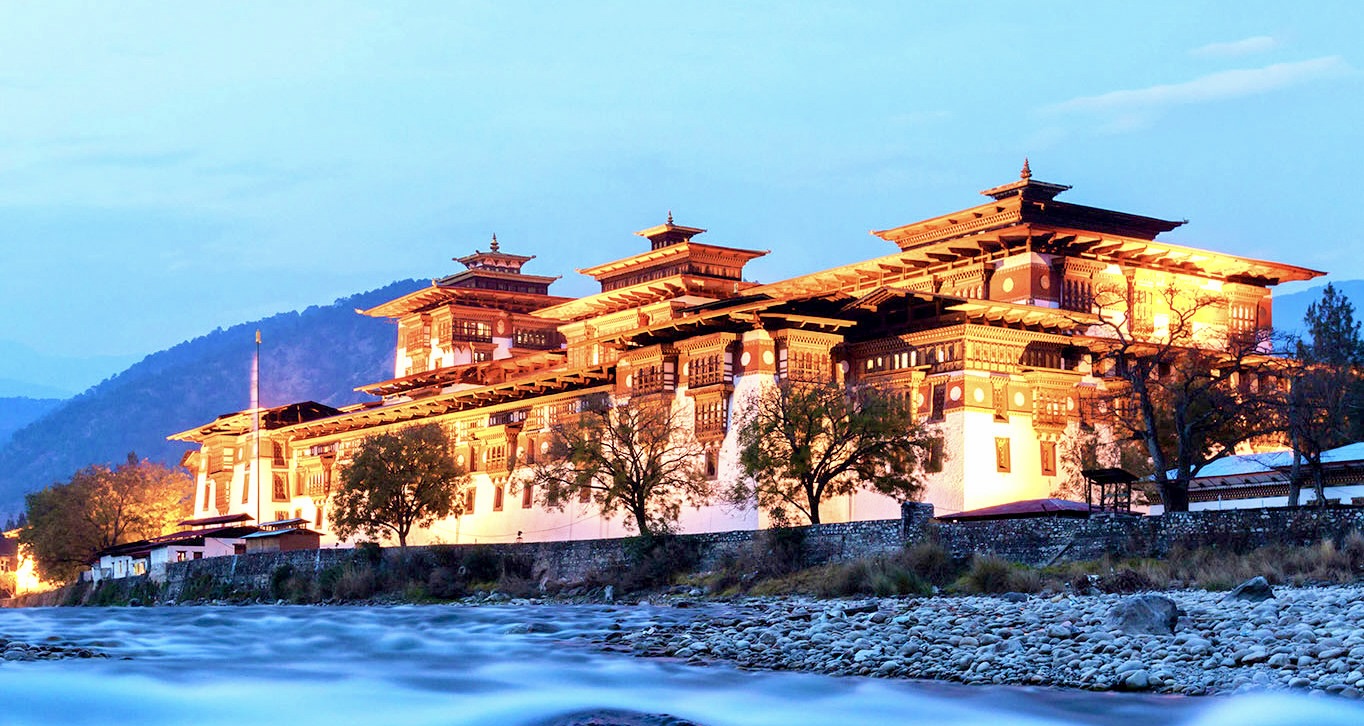
In Thimphu, for example, January temperatures typically range from -2°C at night to around 14-15°C during the day. Summer months (June-August) are warmer but still pleasant, with temperatures generally between 15°C at night and 27°C during the day. The central valleys receive approximately 650 mm of annual rainfall, considerably less than the southern regions.
The central belt experiences distinct seasons, with the monsoon season bringing most of the annual precipitation between June and September. Spring (March-May) and autumn (September-November) offer the most comfortable weather conditions, making these seasons particularly popular for tourism and trekking. This temperate zone is also where most of Bhutan's cultural and historical sites are located, including many important dzongs (fortresses) and monasteries.
Northern/High-Altitude Areas: Cold climate with freezing winters
Northern Bhutan, dominated by the Himalayan high mountain areas with elevations exceeding 3,000 meters, experiences an alpine climate. This region is characterized by low temperatures, limited accumulated heat, and strong winds throughout the year. Areas above 5,000 meters have a particularly harsh climate similar to arctic tundra conditions.
Winter months in the northern regions are severe, with temperatures frequently dropping well below freezing. Even during summer, the northern highlands remain cool, with many areas maintaining snow cover on the highest peaks year-round. Annual precipitation in this region is significantly lower than in the rest of the country, averaging only about 40 mm, primarily in the form of snow.
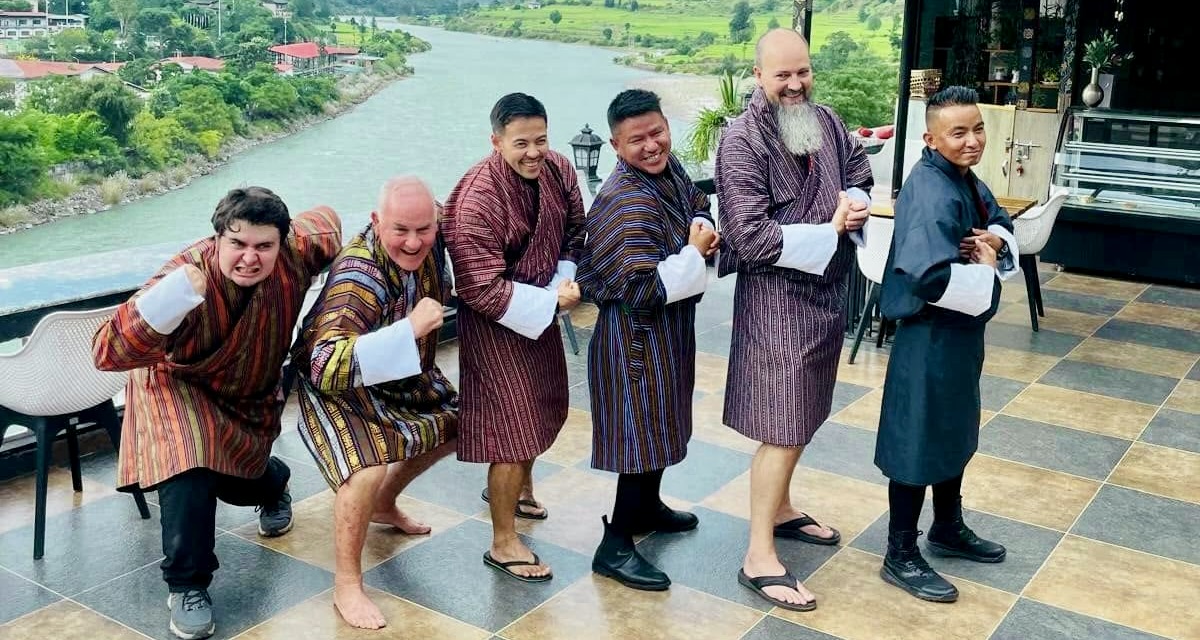
The extreme northern border areas feature spectacular snow-capped peaks and alpine meadows. Gangkhar Puensum, Bhutan's highest peak at 7,570 meters, creates its own weather patterns and remains unclimbed, adding to the mystique of this remote region. The harsh climate limits permanent human settlements, with the population primarily consisting of nomadic herders who move seasonally with their yaks and livestock.
This dramatic variation in climate across relatively short distances makes Bhutan's weather patterns among the most diverse for a country of its size, creating distinct ecological zones and supporting a remarkable biodiversity from subtropical to alpine environments.
Prime Months to Experience Bhutan
October-December: Peak season with ideal weather conditions
The period from October to December stands as the premier time to visit Bhutan, offering travelers the most favorable conditions. During these months, the air is remarkably clear and fresh with predominantly sunny skies, creating perfect conditions for exploration. The temperature is pleasantly mild, averaging between 10-22°C (50-71°F), making outdoor activities comfortable and enjoyable.
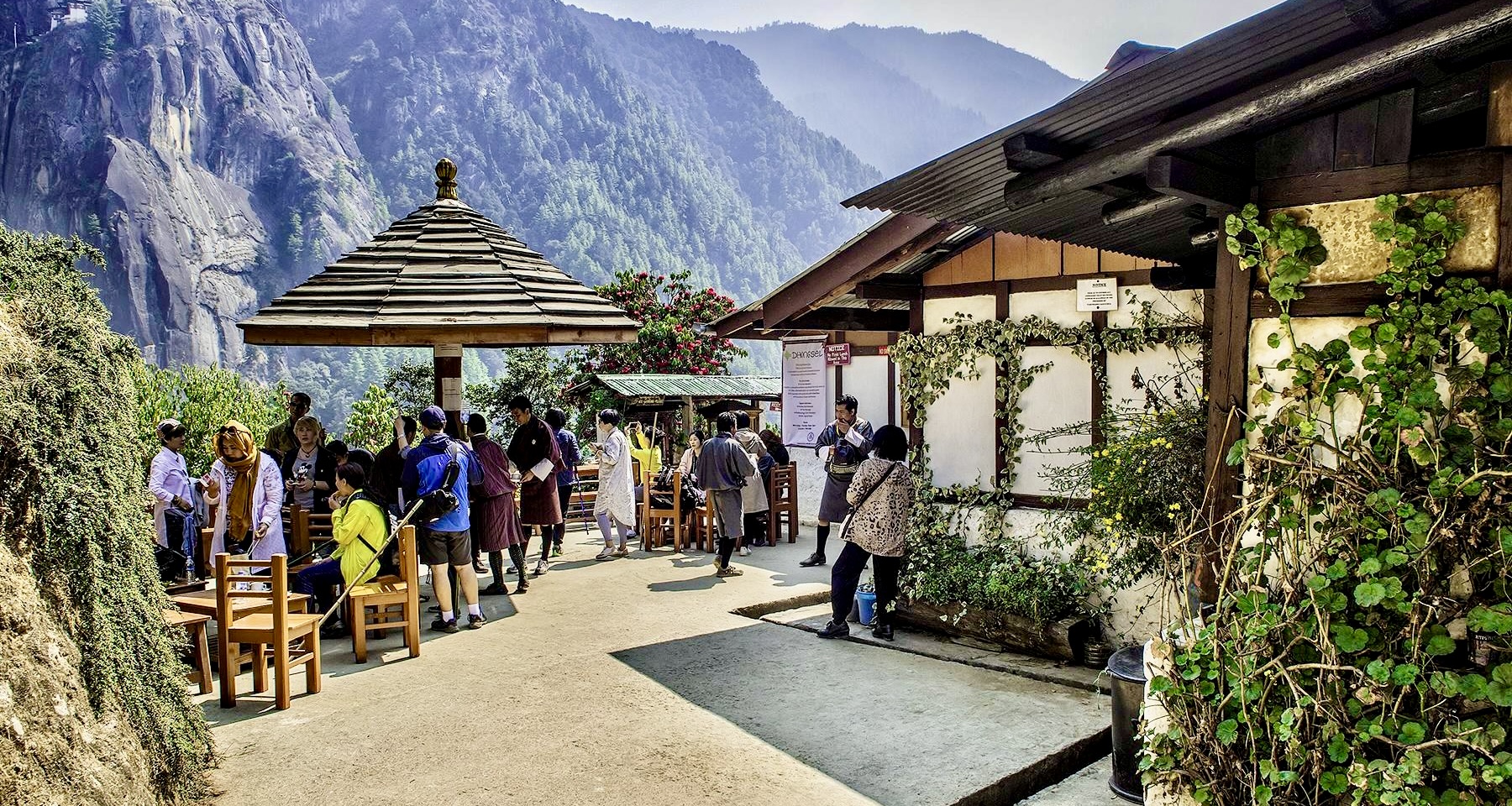
October is particularly popular, with about 80% of all international visitors choosing this month for their Bhutanese adventure. The crystal-clear skies provide spectacular views of the Himalayan mountain ranges, while the comfortable temperatures make it ideal for hiking and trekking adventures. However, this popularity means you'll need to plan well in advance to secure your preferred accommodations and flights.
November continues this excellent weather pattern with very dry conditions and clear skies, providing photographers with stunning opportunities to capture snow-capped mountains against vibrant prayer flags. It's also when the endangered black-necked cranes migrate to the Phobjikha Valley, with a special festival held in Gangtey to celebrate their arrival.
December maintains the dry, clear conditions, though temperatures begin to drop, especially at night. The crisp winter air creates exceptional visibility for mountain views, and the valleys remain pleasantly sunny with far-reaching vistas across the Himalayas.
March-April: Spring beauty with blooming rhododendrons
Spring in Bhutan, particularly March and April, offers a magnificent alternative to the autumn months. As winter retreats, the landscape transforms dramatically with hillsides covered in magnificent rhododendrons, magnolias, jacarandas, primroses, and violets. This colorful display makes spring the second-most popular time to visit Bhutan.
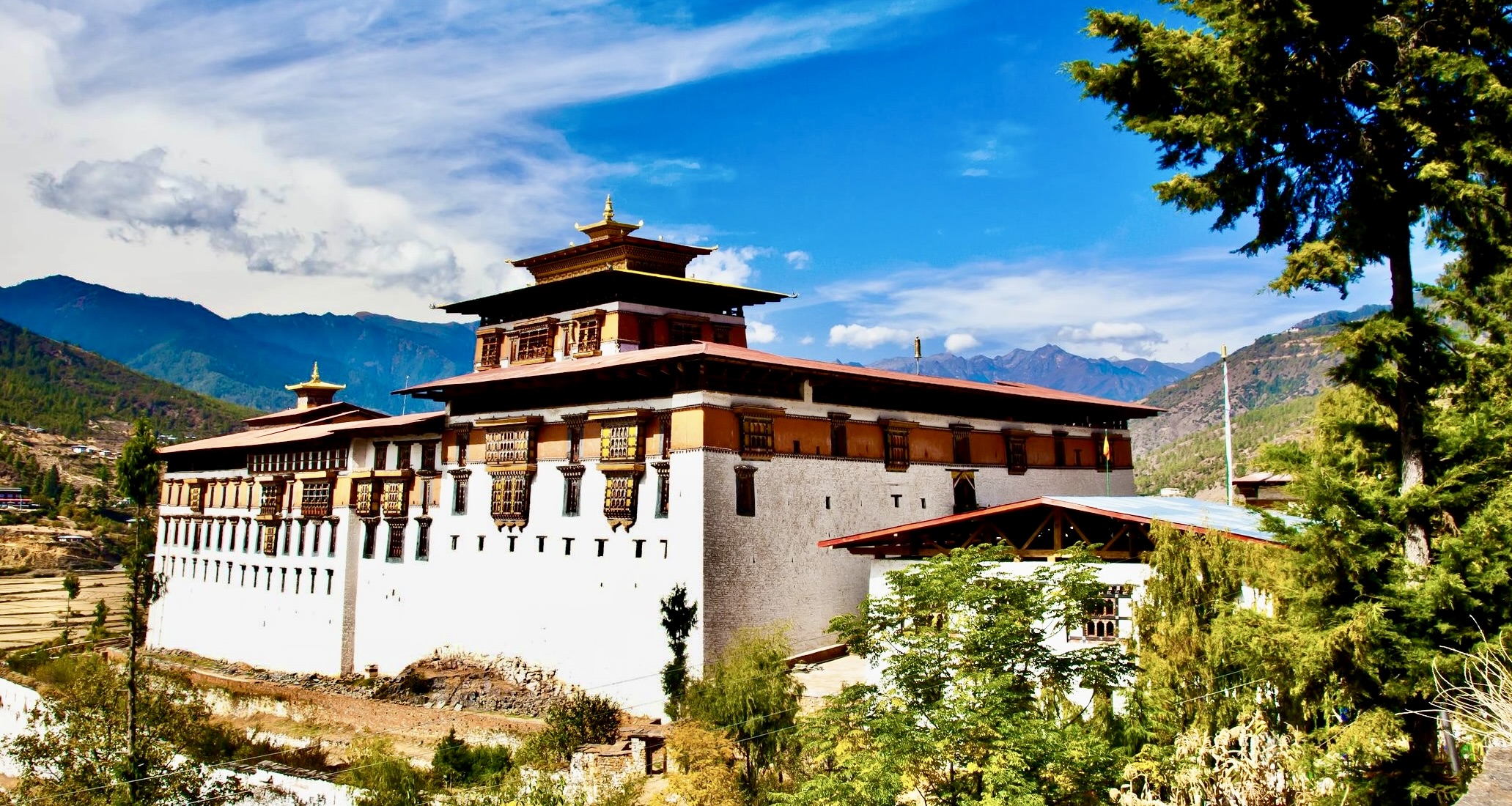
March marks the beginning of the trekking season as the weather becomes milder and skies remain predominantly clear. Mornings might still carry a chill, but daytime temperatures are comfortable, typically ranging from 12-16°C (54-61°F), creating excellent conditions for sightseeing and photography.
April witnesses the continuation of the wildflower blooms, particularly the magenta rhododendrons that carpet entire hillsides. This month is also optimal for wildlife enthusiasts, with abundant birdlife and improved chances of spotting other wildlife. Temperatures rise to about 14-17°C (57-63°F) in most regions, providing comfortable conditions for hiking and exploring.
One of Bhutan's most important festivals, the Paro Tshechu, typically takes place in early April, drawing numerous visitors. If you're planning to attend this colorful masked dance festival, we recommend booking your accommodations and travel arrangements well in advance.
January-February: Winter photography opportunities with snowy landscapes
While January and February constitute Bhutan's winter season with considerably colder temperatures, these months offer unique advantages for the adventurous traveler. In the mountains above 3,000 meters (9,800 feet), heavy snow creates dramatic winter landscapes, while the valleys below experience chilly but generally sunny conditions.
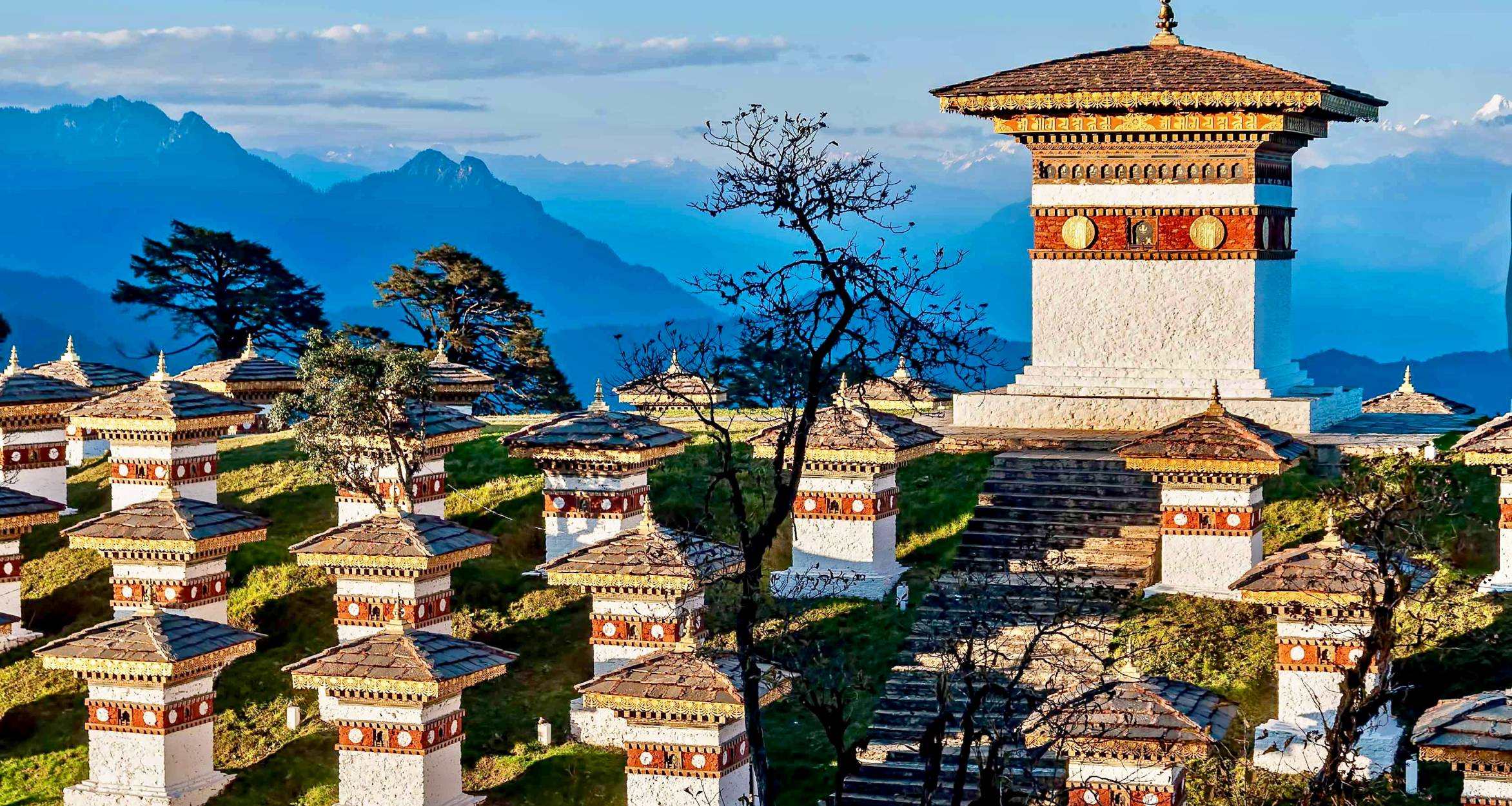
January is the coldest month in Bhutan, with temperatures in Paro dropping to as low as -6°C (21°F) at night, though daytime highs can reach a comfortable 7°C (45°F). The striking contrast between snow-covered peaks and clear blue skies creates a photographer's paradise. Prayer flags fluttering against snowy backdrops make for particularly iconic images.
February sees a slight warming trend toward the end of the month, with temperatures beginning to rise. The winter landscape remains intact, particularly in higher elevations, offering the last opportunity of the year to capture Bhutan's stunning winter scenery.
During these winter months, visitor numbers are significantly lower, allowing for a more intimate experience at major attractions such as Taktsang Goemba (Tiger's Nest) and various dzongs. However, travelers should note that some mountain passes may be blocked by snow, potentially restricting access between western and central valleys. Proper warm clothing is essential, especially for evenings when temperatures drop considerably.
Must-Visit Destinations by Season
Tiger's Nest Monastery: Best viewed in clear autumn weather
When it comes to Bhutan's iconic attractions, Tiger's Nest (Paro Taktsang) is undoubtedly at the top of the list. This breathtaking monastery, perched dramatically on a cliff ledge about 900 meters above the Paro Valley, is best experienced during autumn months (September to November).
During this season, the skies are crystal clear after the summer monsoons, providing unparalleled views of this magnificent structure against the backdrop of the Himalayan peaks. The clear autumn air enhances photography opportunities, allowing visitors to capture the monastery in all its glory. With temperatures ranging from 9°C to 20°C in October, the weather is perfectly comfortable for the challenging hike up to the monastery.

We recommend starting your hike early in the morning to avoid any afternoon clouds that might obscure your views. The 4.3 km trail takes approximately 3-5 hours to ascend, but the autumn weather makes this journey much more pleasant with cool, dry conditions that are ideal for trekking.
Phobjikha Valley: Ideal for black-necked crane viewing (November-February)
The picturesque Phobjikha Valley transforms into a bird watcher's paradise from late October through mid-February when the endangered black-necked cranes migrate from the Tibetan Plateau to their winter feeding grounds. This World Heritage Site becomes home to approximately 600 of these majestic birds during winter.
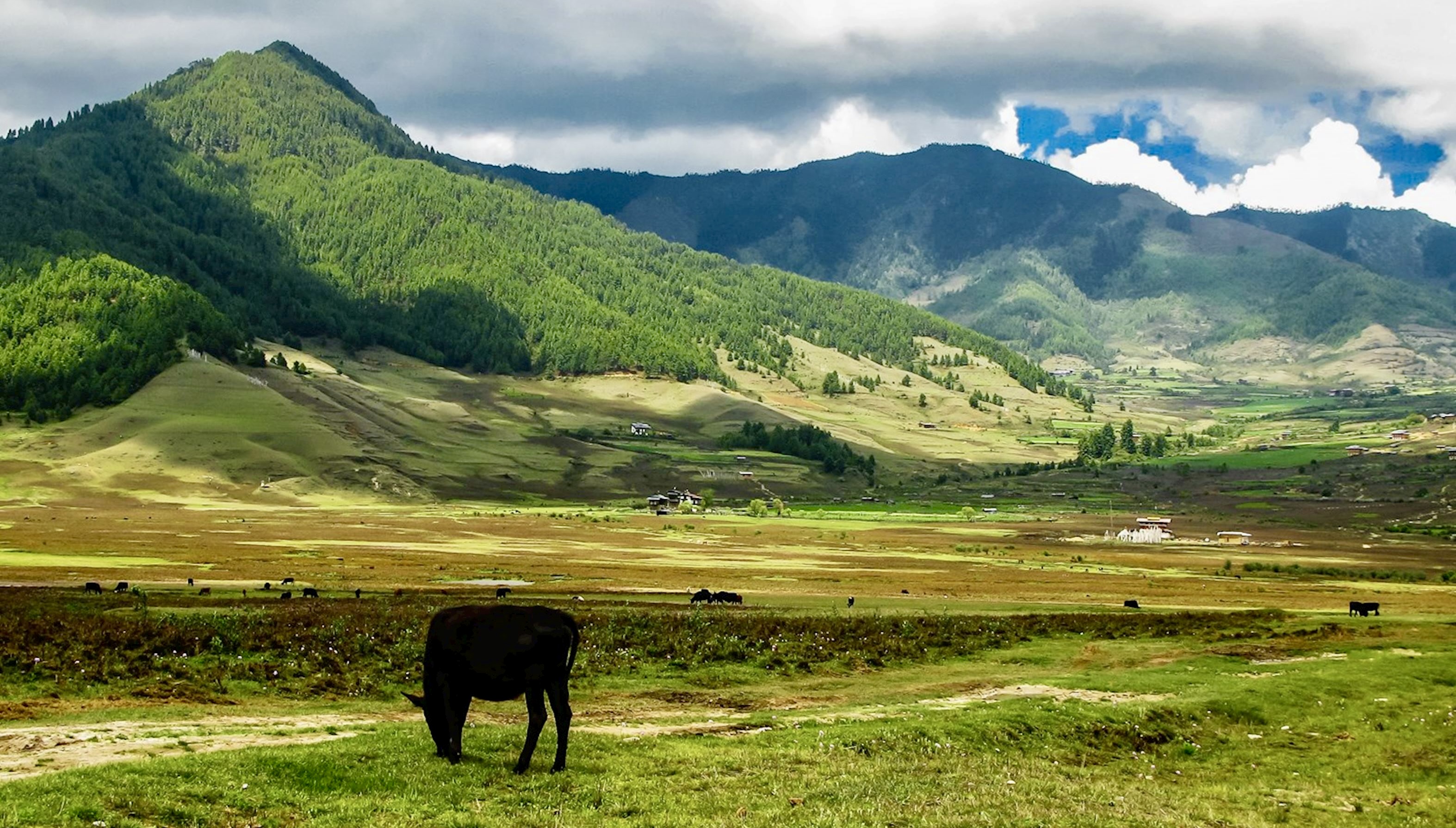
November is particularly special as it hosts the Black-Necked Crane Festival in the courtyard of Gangtey Monastery. This vibrant celebration promotes conservation efforts for these rare birds and features traditional dances, music, and local crafts. If you're a wildlife enthusiast, this is the perfect time to visit this serene valley.
Despite winter temperatures that can drop to 4°C in November and even lower in subsequent months, the clear skies and warmer valleys in the south make for comfortable crane viewing. The valley's stunning landscape, blanketed in winter hues, offers a tranquil experience with far fewer tourists than during peak seasons.
Punakha Valley: Most beautiful in spring flowering season
Punakha Valley, home to Bhutan's largest and second oldest dzong, reveals its true splendor during the spring months of March to May. What makes this season particularly magical is the blooming of the vibrant purple jacaranda trees that surround the magnificent Punakha Dzong, creating a breathtaking contrast against the white fortress walls.
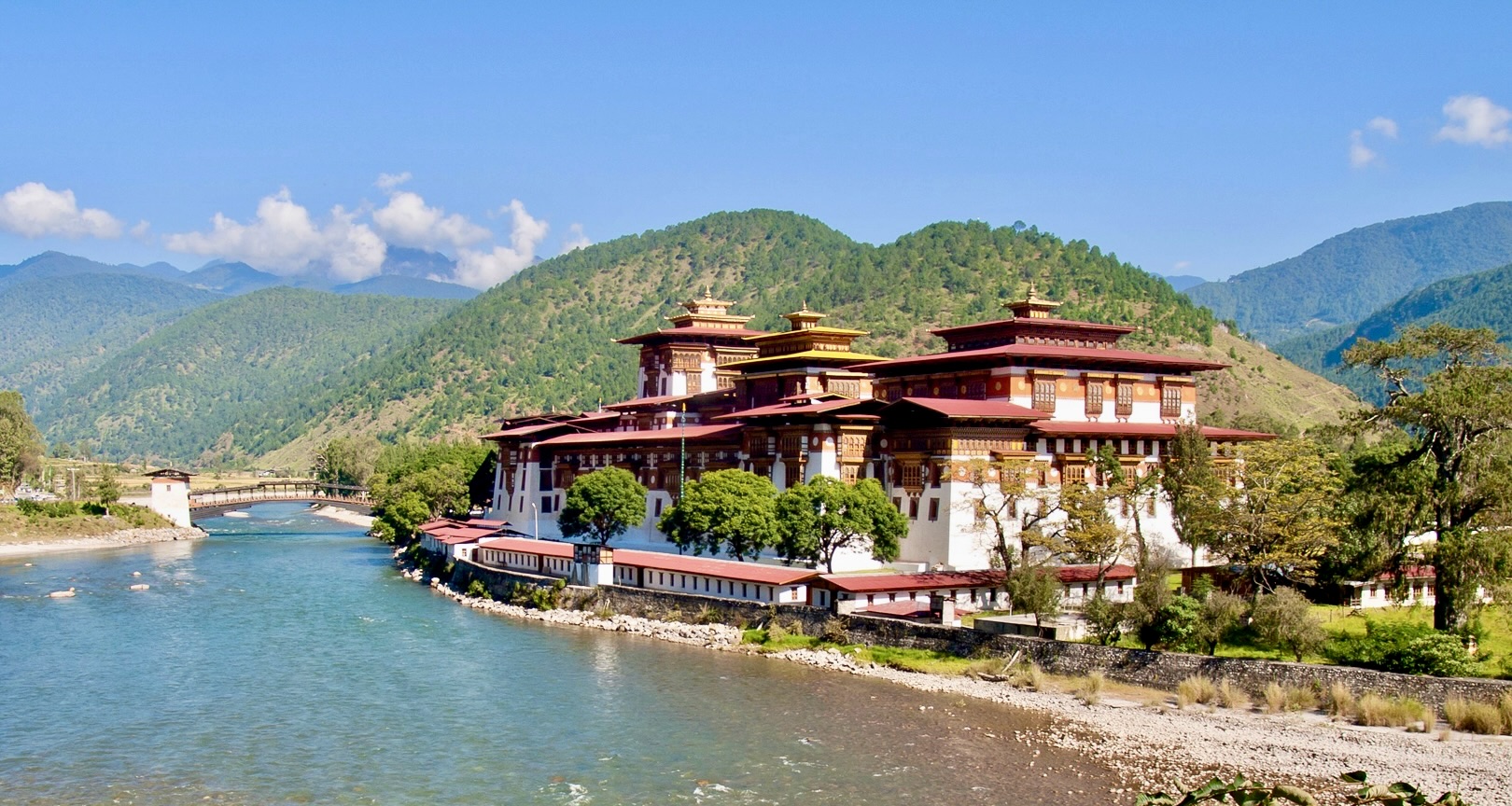
Spring temperatures in Punakha are quite pleasant, ranging from 8°C to 26°C in April, making it comfortable for exploration. The valley becomes a tapestry of colors as rhododendrons and other wildflowers carpet the hillsides. The lush green rice paddies that line the Mo Chhu and Po Chhu rivers add to the valley's picturesque charm.
For adventure seekers, spring is also an excellent time for white water rafting along these rivers, offering a unique perspective of the dzong from the water. The warm but not hot weather, combined with the valley's lower altitude (1,200m), creates ideal conditions for outdoor activities.
We recommend spending at least two days in Punakha during spring to fully appreciate its natural beauty and cultural significance. Don't miss the opportunity to cross the 160-meter-long Punakha Suspension Bridge for spectacular views of the dzong and surrounding landscape in its spring glory.
Cultural Festivals Worth Planning Around
Spring Festivals: Paro Tshechu in March/April
The Paro Tshechu stands as one of Bhutan's most magnificent spring festivals, typically held in March or April. This vibrant celebration lasts for several days and culminates with the unfurling of a giant thangka (religious scroll painting) known as a Thongdrel. We recommend witnessing this rare display that occurs only at dawn on the final day, as it's believed to cleanse onlookers of their sins.
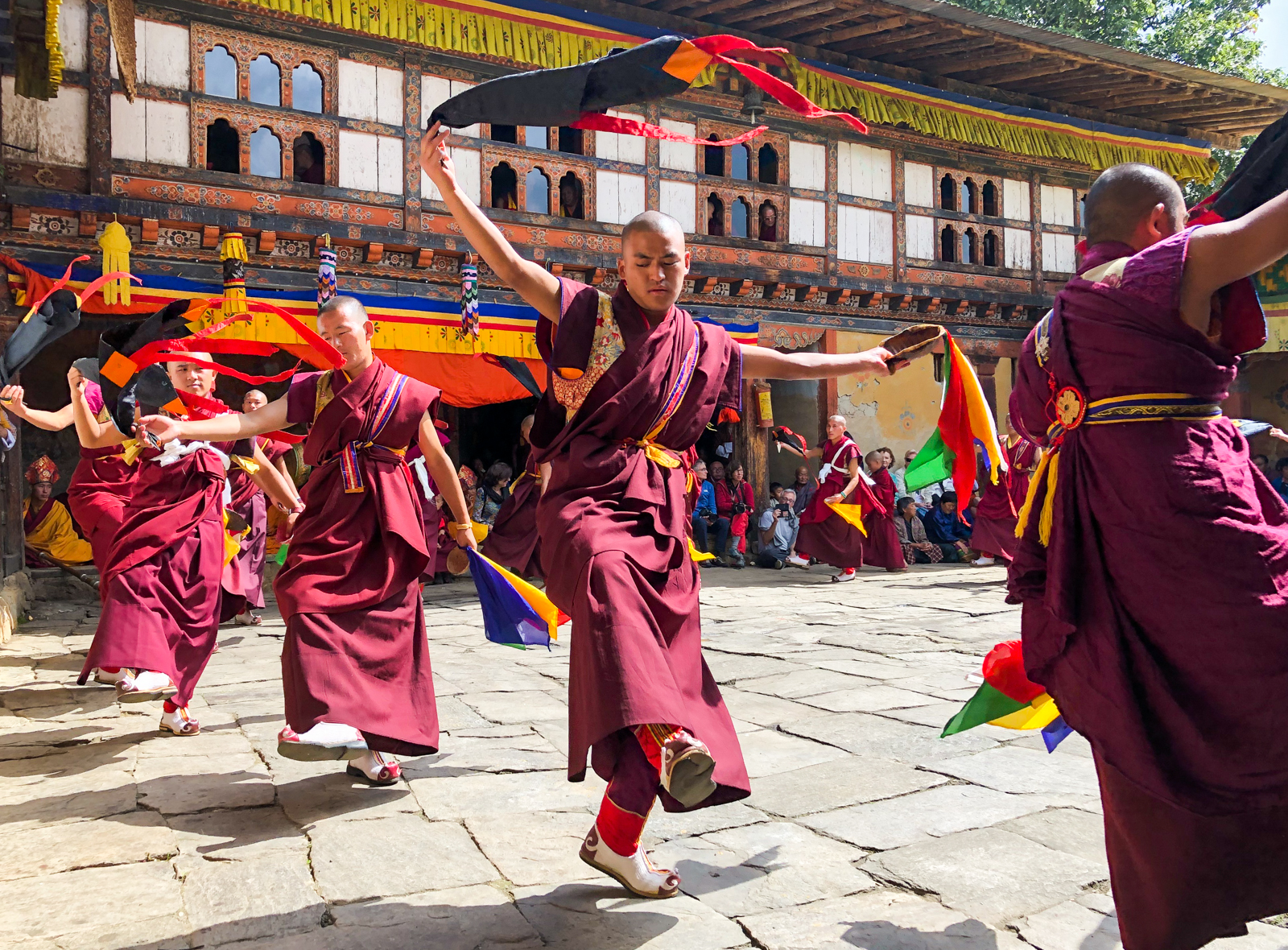
During Paro Tshechu, monks and laymen perform elaborate Cham dances wearing colorful masks and costumes. Each dance tells a story from the life of Guru Rinpoche (Padmasambhava), who brought Buddhism to Bhutan in the 8th century. For photographers, this festival offers exceptional opportunities to capture the essence of Bhutanese spiritual tradition.
Autumn Celebrations: Thimphu Tshechu in September/October
The Thimphu Tshechu is one of the largest and most famous festivals in Bhutan, taking place in September or October at the Tashi Chhodzong in the capital city. As the nation's grandest festival, it draws thousands of locals and tourists alike for several days of spectacular masked dances and religious performances.
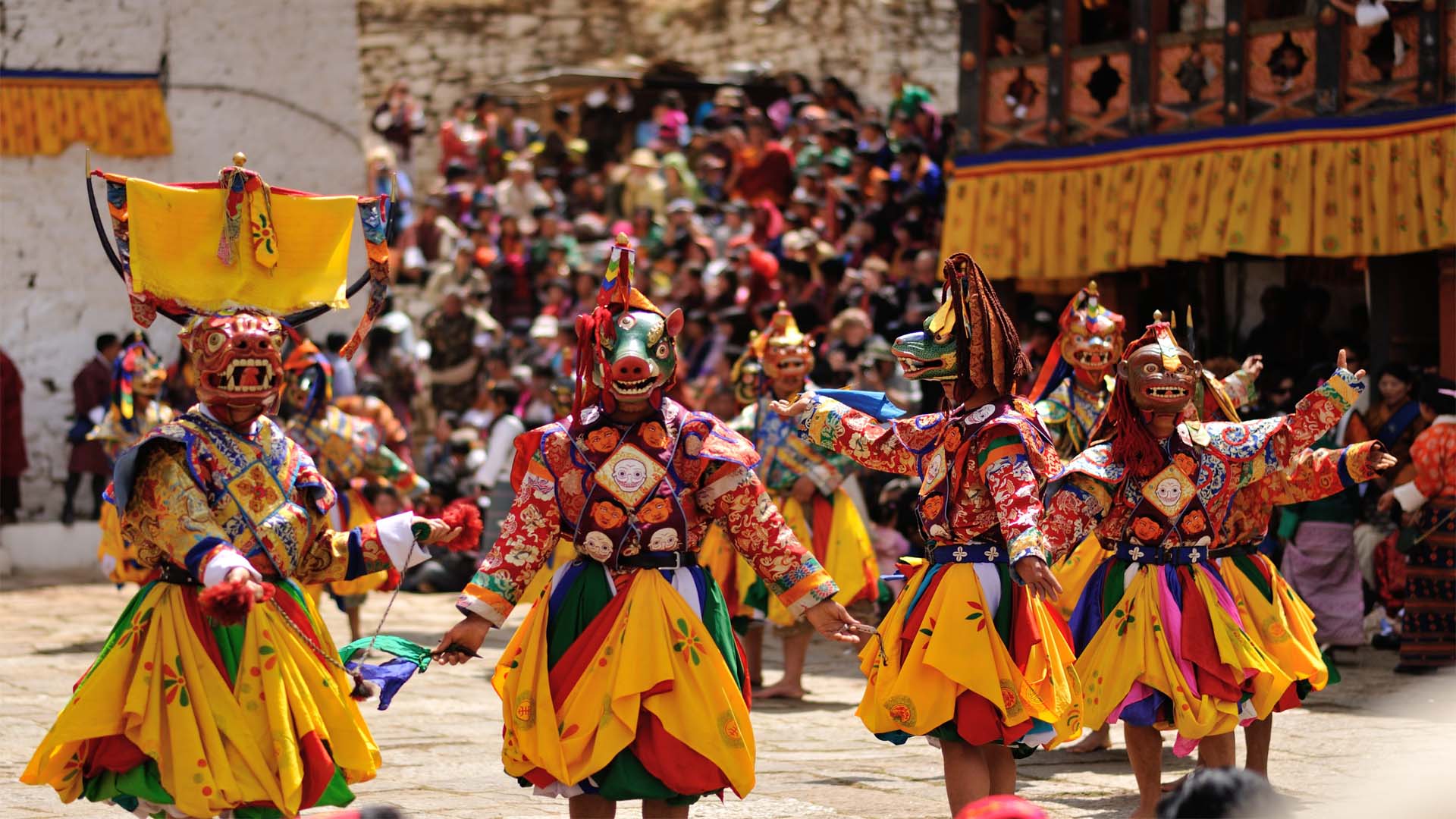
We've found that the Thimphu Tshechu perfectly showcases Bhutan's cultural richness with its array of elaborate and colorful dances. The festival features numerous ceremonial performances that depict moral vignettes, spiritual tales, and the triumph of good over evil. For visitors, this autumn celebration provides an unparalleled window into Bhutanese Buddhist culture and community spirit.
Winter Events: Black-Necked Crane Festival in November
The Black-Necked Crane Festival, held in November at Gangtey Gonpa in the picturesque Phobjikha Valley, celebrates the arrival of these endangered birds during their annual winter migration. Unlike the religious Tshechus, this unique festival combines environmental conservation with cultural celebration.
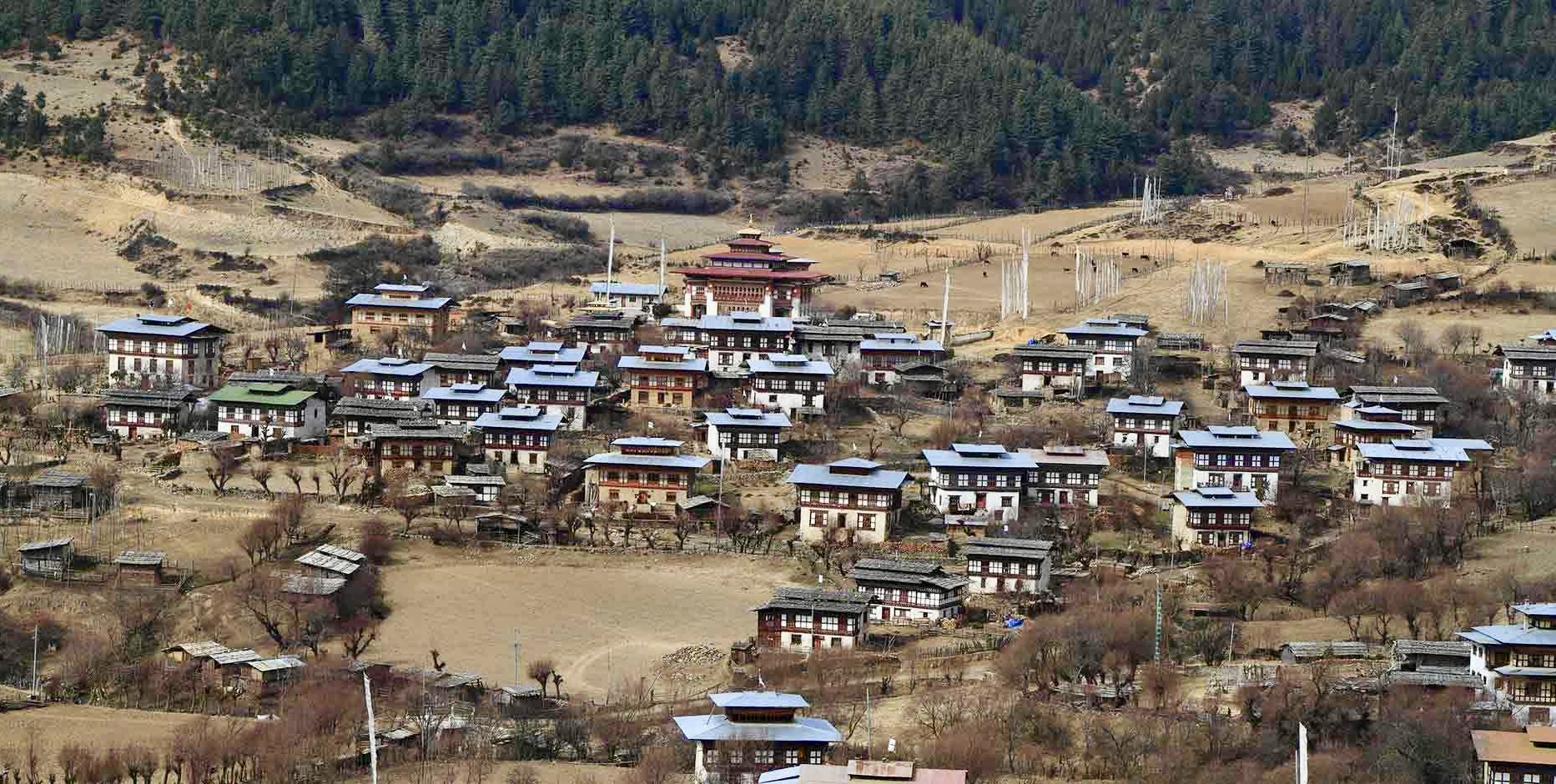
During this festival, we encourage visitors to witness the special dances and songs that emulate the movements of the black-necked cranes. Local children perform these dances wearing crane-inspired costumes, creating a poignant celebration of Bhutan's commitment to environmental preservation. The festival also serves as an educational platform to raise awareness about the importance of protecting these rare birds and their habitat.
For travelers visiting Bhutan in winter, this festival offers not only cultural immersion but also breathtaking views of the Phobjikha Valley's winter landscape while highlighting the deep connection between Bhutanese spiritual beliefs and nature conservation.
Practical Travel Considerations
Visa Requirements and Entry Procedures
To visit Bhutan, we require all travelers (except citizens of India, Bangladesh, and the Maldives) to obtain a visa before arrival. The visa process is straightforward but must be completed in advance:
- You'll need to apply through a licensed Bhutanese tour operator who will handle the visa application on your behalf
- The visa fee is USD $40 per person (non-refundable)
- Processing typically takes up to 5 working days
- You must provide a scanned copy of your passport (with at least 6 months validity remaining)
- A recent passport-sized photograph is required
Additionally, all visitors must pay the Sustainable Development Fee (SDF) of USD $100 per person per night. Children aged 6-12 pay a reduced rate of $50, while those under 6 are exempt from this fee.
Once your visa is approved, you'll receive a visa clearance letter, which must be presented at immigration upon arrival. Only after receiving this letter can you book your flights to Bhutan.
Currency and Banking Facilities
The official currency of Bhutan is the Ngultrum (BTN), which is pegged to the Indian Rupee. When visiting Bhutan, we recommend you:
- Carry cash as your primary payment method
- Be aware that credit cards are increasingly accepted in Bhutan, but system outages are common
- Note that Indian Rupees are widely accepted, though denominations above 100 may not be accepted
- Use ATMs available in major cities, though their availability is limited
- Inform your bank of your travel plans to avoid issues with international transactions
Currency restrictions apply: visitors cannot bring in or take out more than $10,000 or equivalent.
Language and Communication Tips
Dzongkha is Bhutan's official language, but English is widely spoken, especially in tourist areas and by guides. To enhance your communication experience:
- Most guides speak excellent English, making communication relatively easy
- Learning a few basic Dzongkha phrases can enhance your cultural experience
- Be aware that mobile connectivity may be limited in remote areas
- Wi-Fi is available in most hotels, but it may be slow or unreliable
- Consider obtaining a local SIM card for better connectivity
- Remember that cybersecurity risks exist, so be cautious when connecting to public Wi-Fi
Accommodation Options for Different Budgets
Bhutan offers various accommodation options, though all must meet certain quality standards as part of the tourism policy:
- Standard Hotels: Clean, comfortable accommodations with basic amenities, typically 3-star equivalent
- Luxury Hotels and Resorts: High-end options like Amankora, Uma, and Taj properties offer premium experiences
- Heritage Hotels: Converted traditional buildings offering authentic cultural experiences
- Homestays: Available in some areas, providing an immersive cultural experience
- Farmstays: Rural options allowing visitors to experience traditional Bhutanese farming life
Note that accommodation in rural areas may be more basic than in Thimphu or Paro. Your tour operator can recommend options that best match your budget and preferences. During peak festival seasons, we advise booking well in advance as accommodations fill quickly.
For those seeking medical assistance, the Jigme Dorji Wangchuck National Referral Hospital in Thimphu is the best option for urgent care. However, for serious conditions, medical evacuation to a neighboring country may be necessary, so comprehensive travel insurance is essential.
Culinary Experiences in Bhutan
Traditional Bhutanese Dishes to Try
When visiting Bhutan, exploring the local cuisine is an essential part of understanding the country's culture. At the heart of Bhutanese cuisine is Ema Datshi, the national dish consisting of chilies and cheese. This fiery yet creamy stew represents the soul of Bhutanese cooking and is served with red rice, a nutritious grain grown in the valleys of Bhutan.
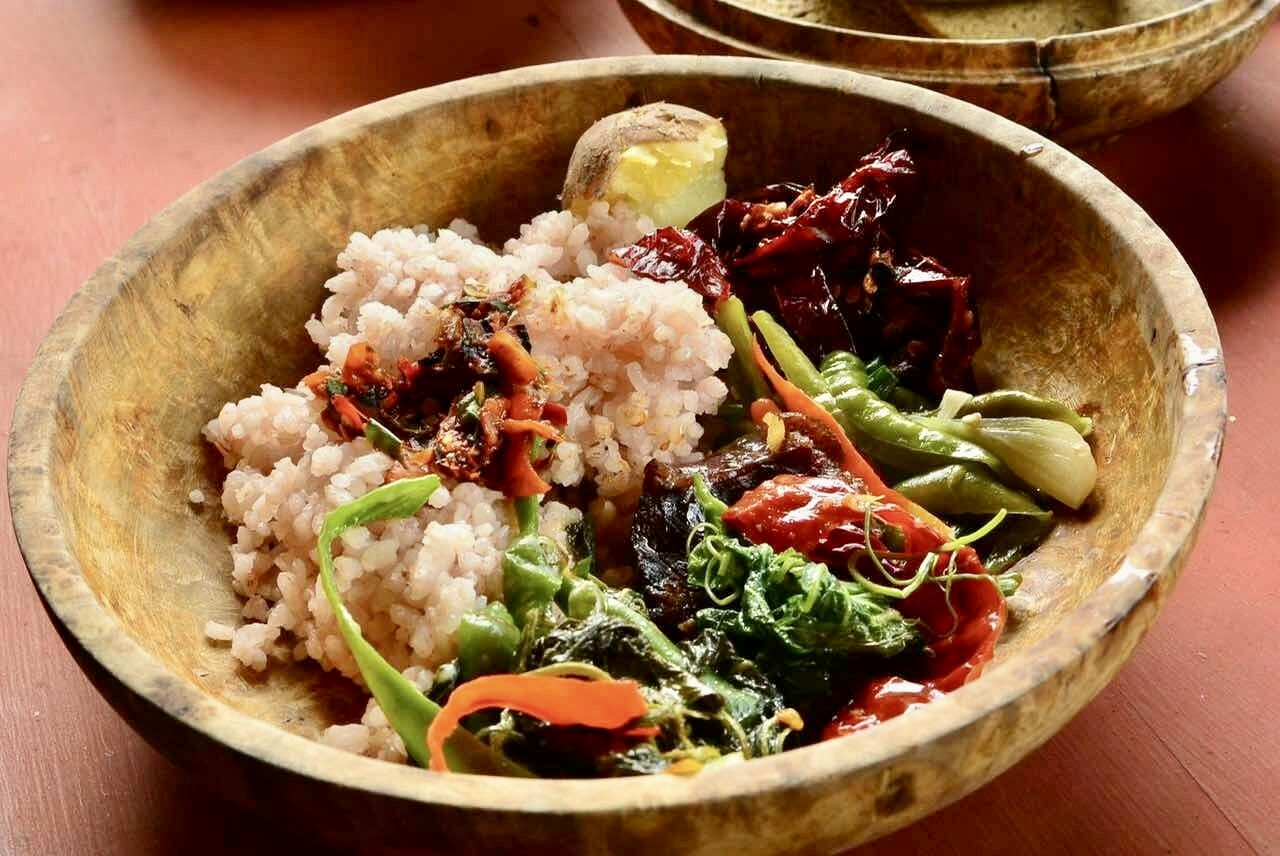
For meat lovers, we recommend trying Phaksha Paa, a savory dish of stir-fried pork with red chilies and radishes. The distinctive smoky flavor makes it a favorite among locals and tourists alike. Another must-try meat dish is Jasha Maru, a spicy chicken curry infused with ginger that offers a perfect balance of heat and flavor.
Vegetarians will delight in dishes like Kewa Datshi (potatoes and cheese) and Shamu Datshi (mushrooms and cheese). These variations of the national dish showcase the versatility of Bhutanese cooking while maintaining the characteristic creamy, spicy profile that defines the cuisine.
Don't miss Hoentay, buckwheat dumplings filled with turnip greens and cheese, especially if you're visiting the Haa Valley region. These steamed delicacies offer a hearty taste of local ingredients and traditional cooking methods.
Spice Levels and Dining Recommendations
Bhutanese cuisine is famously spicy, with chilies used as a vegetable rather than just a seasoning. We've observed that for many visitors, the heat level can be quite surprising at first. If you're sensitive to spicy food, we recommend asking your guide or server to request milder versions of traditional dishes.
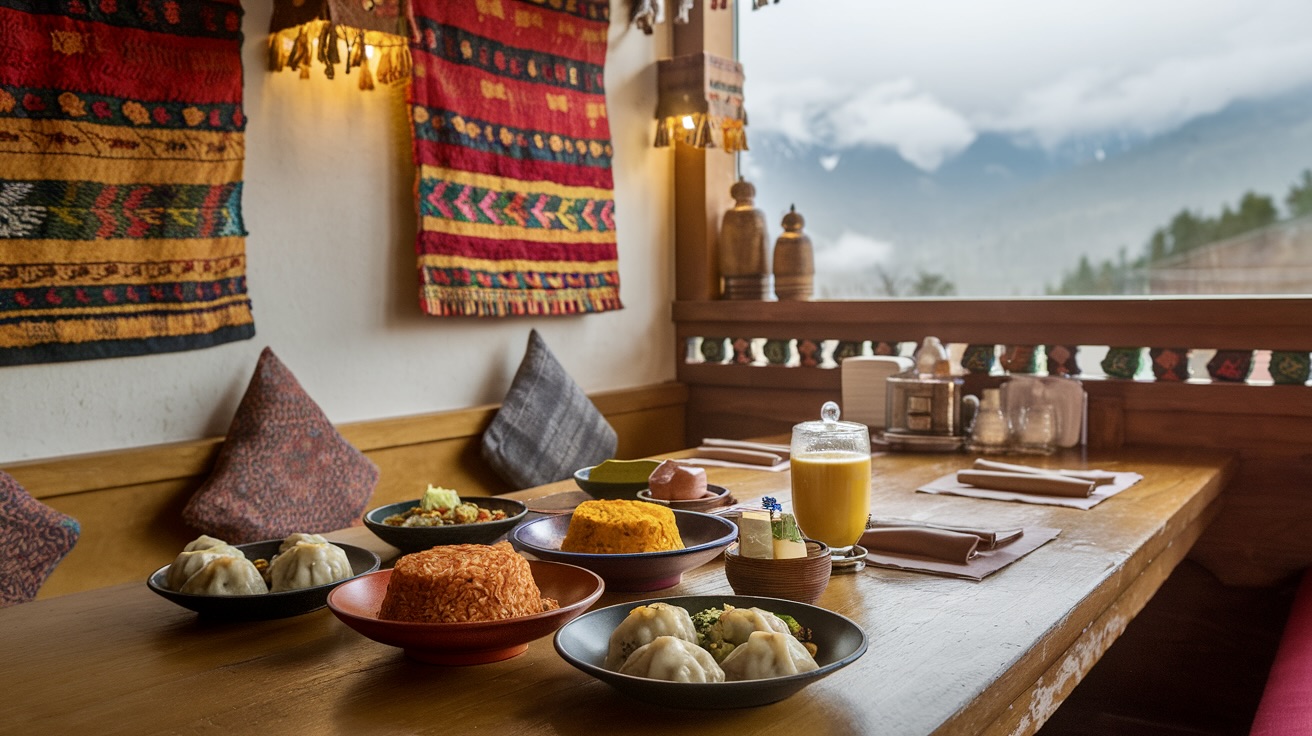
Most hotels and restaurants catering to tourists offer adjustable spice levels, ensuring you can enjoy authentic flavors without overwhelming your palate. The cheese in many Bhutanese dishes helps balance the heat of the chilies, creating a more approachable experience for those unaccustomed to high spice levels.
For an authentic dining experience, we suggest visiting the Folk Heritage Museum Restaurant in Thimphu, where traditional dishes are served in wooden bowls called dapas. Babesa Village Restaurant in Thimphu and Tenphey in Punakha also offer excellent traditional cuisine in settings that showcase Bhutanese culture.
One of our favorite culinary experiences is dining at a local farmhouse. Many tour operators can arrange meals with families, providing an immersive opportunity to enjoy home-cooked Bhutanese food while connecting with locals. These meals often feature seasonal produce harvested from nearby fields, offering the freshest possible ingredients.
International Food Options for Varied Palates
While we encourage trying local cuisine, we understand that some travelers may need alternatives to the spicy Bhutanese diet. Most luxury hotels in Bhutan offer international dining options, with menus featuring familiar Western, Indian, and Chinese dishes.
In urban areas like Thimphu and Paro, you'll find restaurants serving continental breakfast options, including eggs, toast, cereals, and fruits. For lunch and dinner, international restaurants offer pasta, sandwiches, and various global cuisines.
Tourist-oriented restaurants typically provide buffet-style meals where you can select from both Bhutanese and international options. This allows you to sample local flavors while having familiar alternatives available.
We've found that many high-end hotels employ chefs trained in international cuisine, ensuring quality alternatives for travelers with specific dietary requirements or preferences. However, we recommend informing your tour operator about any dietary restrictions in advance, as options may be limited in remote areas.
Despite the availability of international cuisine, we encourage all visitors to at least sample traditional Bhutanese dishes. Even if you only taste a small portion of Ema Datshi or try a momo (dumpling), experiencing these flavors adds a valuable dimension to your understanding of Bhutanese culture.
Best Activities by Season
Trekking and Hiking: Optimal in spring and fall
Spring (March to May) and fall (October to November) offer the best conditions for trekking and hiking adventures in Bhutan. During these seasons, the weather is pleasant with clear skies, making them ideal for exploring Bhutan's stunning mountain trails.
In spring, as temperatures rise after winter, the landscape bursts into color with rhododendrons blooming spectacularly across the hillsides. The air is fresh, and trails are generally dry, providing excellent trekking conditions. We recommend popular routes like the Druk Path Trek, Jhomolhari routes, and the Dagala Trek during this period. The temperatures are comfortable, typically ranging from 15-20°C (59-68°F) during the day in most trekking areas.
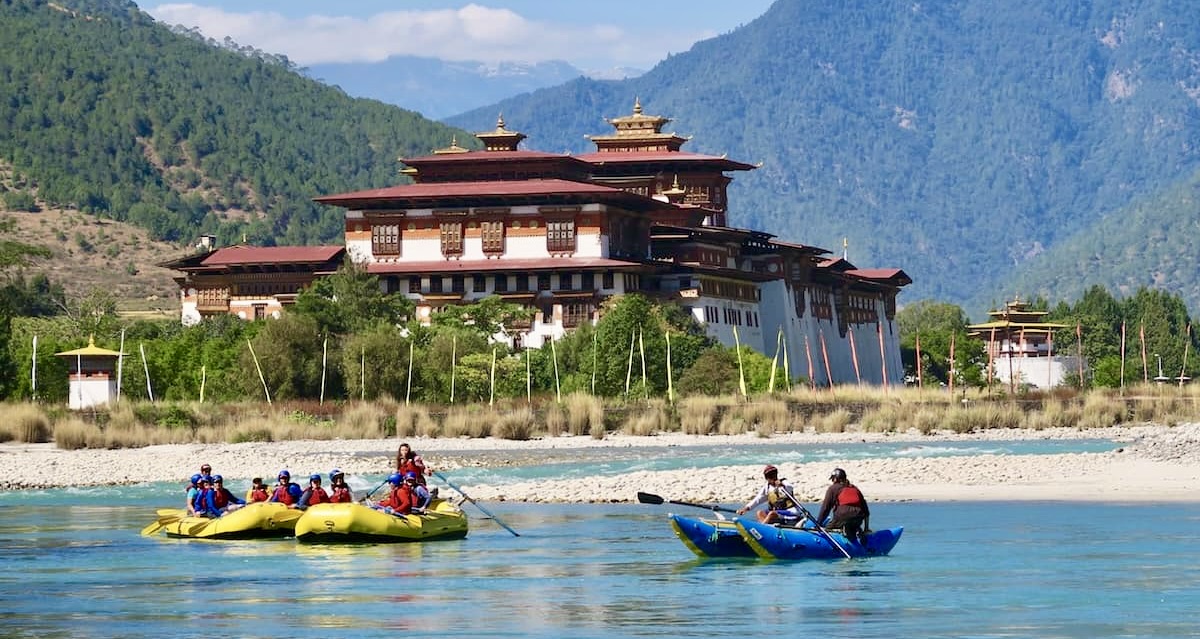
Fall presents perhaps the single best season for trekking adventures in Bhutan. With the monsoon rains gone, October and November feature crystal-clear skies offering spectacular Himalayan panoramas with comfortable daytime temperatures around 20°C (68°F). The Bumthang Trek and routes around Samtengang, Nabji Korphu, and Merak Sakten are particularly rewarding during autumn.
We advise avoiding the summer monsoon season (June to September) for trekking, as heavy rains can make trails muddy, slippery, and dangerous. Winter treks (December to February) are best done at lower altitudes since high mountain passes remain snowbound.
Cultural and Historical Tours: Available year-round
One of the great advantages of Bhutan is that cultural and historical tours can be enjoyed throughout the year, regardless of the season. Even during the monsoon months when trekking might be challenging, exploring Bhutan's rich cultural heritage remains an excellent option.
Summer (June to August), while not ideal for trekking due to monsoon rains, offers a perfect opportunity for indoor cultural activities. This is an excellent time to visit dzongs (fortresses), temples, and museums to learn about Bhutan's unique history and Buddhist traditions. The cultural sites are less crowded during this period, allowing for a more intimate experience.
Winter months (December to February) are also well-suited for cultural tours, especially in the lower-altitude regions like the subtropical Punakha Valley. With comfortable temperatures in these areas and fewer tourists, winter provides a quieter atmosphere for exploring Bhutan's cultural treasures.
We recommend planning your cultural tour around one of Bhutan's spectacular religious festivals (tsechus) for an enhanced experience. These colorful events feature masked dances and draw local Bhutanese dressed in their finest traditional attire. The Paro Tsechu (usually in late March or early April) and Thimphu Tsechu (September) are among the most popular, though smaller regional tsechus often provide more authentic experiences with fewer tourists.
Photography Opportunities: Unique advantages in each season
Bhutan offers exceptional photography opportunities year-round, with each season presenting its own unique advantages for capturing the beauty of the Dragon Kingdom.
Spring (March to May) is a photographer's dream, with rhododendrons and other wildflowers creating vibrant carpets of color across the hillsides. The clear spring light combined with flowering landscapes makes for stunning nature photography. The famous rhododendron blooms peak between March and May, offering remarkable color contrasts against the backdrop of green valleys and snow-capped mountains.
Autumn (October to November) provides the clearest views of the Himalayan peaks, making it optimal for landscape photography. The crisp autumn air and excellent visibility allow photographers to capture the majestic mountains in their full glory. Additionally, the colorful autumn leaves create picturesque scenes throughout the country.

Summer months, despite the rain, offer unique photographic opportunities with lush green landscapes and dramatic cloud formations. High-altitude wildflowers reach their peak in July, including the rare blue poppy, anemones, primula, and irises. When the clouds part after rainfall, the freshly washed landscapes provide exceptional clarity for photography.
Winter photography benefits from the clear skies and soft light. In the Phobjikha Valley between late October and mid-February, photographers can capture the rare black-necked cranes that migrate from Tibet. The contrast of these graceful birds against winter landscapes creates memorable images.
For the best photography results, we recommend early morning and late afternoon shoots when the light is softer and more flattering, regardless of the season you choose to visit Bhutan.
Conclusion
Choosing the right time to visit Bhutan can significantly enhance your experience in this mystical Himalayan kingdom. Spring (March to May) and autumn (September to November) offer ideal weather conditions for most travelers, with clear skies perfect for mountain views and comfortable temperatures for trekking and outdoor activities. Winter provides unique opportunities for bird watching and uncrowded attractions, while summer reveals lush landscapes despite occasional rainfall.
When planning your Bhutanese adventure, consider aligning your visit with the vibrant cultural festivals that showcase the country's rich heritage, or focus on regional variations to experience the diverse landscapes and climates across the kingdom. Whether you're drawn to the spiritual monasteries, the breathtaking mountain vistas, or the unique culinary delights, timing your visit thoughtfully will help you experience the magical blend of natural beauty and cultural richness that makes Bhutan truly special.
Contact Luxury Holidays Nepal to craft your perfect Bhutanese journey today.
If you need any further information, please contact us by email: [email protected], Phone: +977- 985 100 5129 (WhatsApp).




